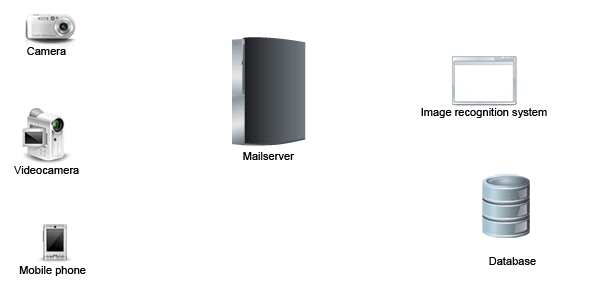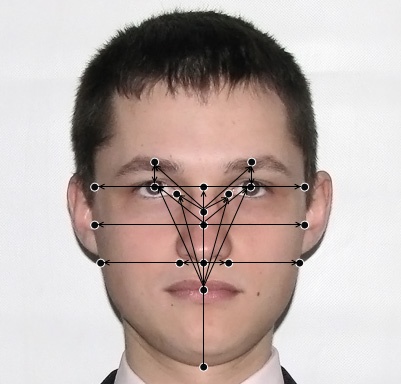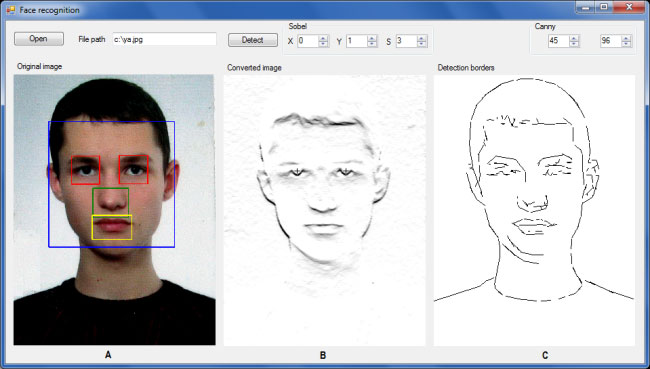Kolesnik Andrey
Faculty: Computer Science and Technologies
Speciality: Software Engineering
Department: Applied mathematics and informatics
Master's theme:
Distributed software system for image recognition
Scientific adviser: Ph.D. Y. V. Ladyzhensky
Abstract master's qualification work
«Distributed software system for image recognition»
Introduction
Recognition of images with development of computer technologies became the important problem for the person. On the basis of recognition of images many systems of automatic identification are constructed.
There is a wide range of tasks associated with the biometric identification of a person, based on the facial image, iris, fingerprints, voices, ears and nose shape.
Purposes and tasks
The aim is to develop a master's work of a distributed system for automatic recognition of images in real time. To achieve this goal it is necessary to solve such problems:
- analysis of recognition technologies using distributed computing;
- development of algorithms for distributed systems, image recognition;
- development of a distributed software system for image recognition;
- experimental studies of distributed software system of image recognition.
Subject urgency
As a function of image recognition function is used, which performs the recognition of human faces. Identification of human face can be used in information security for access control, banking, social networks, criminology, computer games, almost any system that requires authentication.
Scientific novelty
Application of the distributed technology for image recognition.
Development of algorithms for face recognition based on anthropometric characteristics of persons able to work in real time on low-contrast images.
System Architecture Detection
The architecture has been developed for maintenance of wide use, availability, stability for recognition system (fig. 1).

Figure 1 – System Architecture Detection ( animation: volume – 26,6 KB, quantity of shots – 24, quantity of repetition cycles – 10, the size – 600x287)
http://en.wikipedia.org/wiki/SMTPThe system works with images, which sources can be photo-and video cameras, phones, PDAs, and various scanners. Images from these devices through the Internet, by e-mail protocols SMTP, IMAP sent to a specific mailbox [1]. E-mail client, which is part of the recognition system, loads the images from the mail server and transmits them to the server recognition, which provides distribution to customers recognition.
Customers recognize distinguished geometric characteristics of individuals and through their performing a comparison with the base image, then the result is transmitted to the server recognition, which carries through the mail server transfers the result to the user [2].
Anthropometric points in the Automatic Identification Systems
The practice of criminology shows that it is necessary to allocate about 30 special points on the image of a human face [3,4], that will be most resistant to small changes (angle, lighting, facial expressions, cosmetics, age-related changes). Groups of points are the following priority: eyes, eyebrows, nose, mouth, on the basis of their possible release of many different parameters for identification. As parameters are used to detect the distance, measured along the contour lines and verticals, as they require less computational costs of obtaining and processing, have a high accuracy of measurement. The most commonly used anthropometric point person in building automated systems to identify people shown in fig. 2.

Figure 2 – Anthropometric points in the Automatic Identification Systems
The developed algorithm of face recognition
For optimum recognition problem of analysis of existing algorithms. After that was chosen such a face recognition scheme [5]:
- Search the face of the image;
- Detection of pupil center of the portrait;
- Rotation and scaling (if necessary) found the face;
- Improving the image contrast using different filter;
- Allocation of anthropometric points using the edge detector (Sobel operator) or underscore some of the facial features («High Boosting»).
Research results
During the search of the person in the picture was originally used by the algorithm Viola-Jones, which is implemented in computer vision OpenCV, an example of the algorithm is shown in fig. 3A.

Figure 3 – The search engine of faces in the image
Detector based on the algorithm Viola-Jones is one of the best indicators of the efficiency ratio recognition / speed. Also, this detector has an extremely low probability of false detection of faces. Viola-Jones algorithm is stable enough (about 20 degrees) to rotate the image. At an angle of inclination of 20 degrees above the percentage of detections drops sharply. However, at small angles to 10 degrees, the algorithm continues to reliably determine the person's face. Unlike real people, random, false detection of other objects do not possess such resistance. This method is based on strengthening the simple classifiers [6]. Strengthening of simple classifiers - an approach to solving the problem of classification (recognition), by combining the primitive "weak" classifiers into a single "strong". Under the "force" qualifier in this case means the effectiveness (quality) for solving the problem of classification [7o detect the pupil center is found in the facial area using Sobel operator, the inversion and the method of Otsu [8]. Sobel operator is a convolution of the original image [9] with two masks of size 3 × 3 individually, and summation of the results. Leased circuits and found Centres pupils, marked by crosses, shown in fig. 3B.
Rotation, scaling, cropping and alignment of the brightness of the image provide the function of the library OpenCV.
The detector edges, other than those listed above, may use the popular and effective edge detector Kenni [10], which has worked well. Kenni operator first performs smoothing halftone image, and then an extended contour segments, tracing adjacent pixels with large values of the modulus of the gradient. The results of his work are shown in fig. 3C
Conclusion
Face recognition based on geometric characteristics requires a reliable mechanism for finding key points for the general case, which is provided by the proposed algorithm. This system realizes the important practical function: recognition is performed in real time through the use of distributed technology Face Detection, the system can work automatically, receiving the input image from the mail server and sending a result of their work via e-mail server.
References
[1] Колесник А.В., Ладыженский Ю.В. Распределенная система распознавания лиц на основе геометрических характеристик / А.В. Колесник, Ю.В. Ладыженский // Інформаційні управляючі системи та комп’ютерний моніторинг (ІУС та КМ-2010) / Материіали I всеукраїнської науково-технічної конференції студентів, аспірантів та молодих вчених – 19-21 травня 2010р., Донецьк, ДонНТУ. – 2010. – с. 29-32.
[2] Колесник А.В., Ладыженский Ю.В. Распределенная интернет-система автоматического распознавания изображений в реальном времени / А.В. Колесник, Ю.В. Ладыженский // Інформатика та ком'ютерні технології / Матеріали V міжнародної науково-технічної конференції студентів, аспірантів та молодих науковців – 24-26 листопада 2009 р., Донецьк, ДонНТУ. – 2009, с. 206-208.
[3] Зинин A.М., Кирсанова Л.З. Криминалистическая фотопортретная экспертиза. – М.: МВД СССР ВНКЦ, 1991. – 88с.
[4] Эксперт-криминалист, портретная экспертиза [Электронный ресурс] / Интернет-ресурс. – Режим доступа: http://www.expert-kriminalist.ru/readers/portret_readingroom
[5] Самаль Д.И. Алгоритмы идентификации человека по фотопортрету на основе геометрических преобразований. Автореферат на соискание ученой степени кандидата технических наук. – Минск, – 2002.
[6] Вежневец А.П., Вежневец В.П. Boosting – Усиление простых классификаторов [Электронный ресурс] / А.П. Вежневец, В.П. Вежневец. – Режим доступа: http://cgm.computergraphics.ru/content/view/112
[7] Ole Helvig Jensen. Implementing the Viola-Jones Face Detection Algorithm. – Kongens Lyngby 2008.
[8] Klette R., Zamperoni P. Handbook of image processing operators // John Wiley & Sons. – Chichester. – 1996.
[9] Форсайт Д., Поинс Ж. Компьютерное зрение. Современный подход. : Пер. с англ. – М.: Издательский дом «Вильямс», 2004. – 928 с. : ил. – Парал. тит. англ.
[10] Шапиро Л., Стокман Дж. Компьютерное зрение; Пер. с англ. – М.: БИНОМ. Лаборатория знаний, 2009. – 752с., 8с. ил.
Note
The master’s work has not completed yet. Completion date is December 2010. Full text can be received from the author or his scientific advisor after this date.
